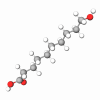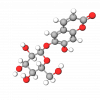Safflower oil is extracted from the seeds plant Carthamus Tinctorius and is an unsaturated oil. Carthamus tinctorius seed oil is a light, naturally stable, liquid oil with a superb emollient property that quickly penetrates the skin barrier. Its uniqueness is derived from an exceptionally high mono-unsaturated level of 90%, like oleic acid, which makes it incredibly stable, achieving higher stability values than other natural liquid oils.
Thanks to its highly unsaturated fatty acids contents, Safflower oil is widely used in the healthy food and cosmetic industry. The oil contains about 80% of linoleic acid which plays a crucial role in the skin and in other tissues. A variety of animal studies have shown that, when the skin is deficient in essential fatty acids, especially linoleic acid or r-linolenic acid, the skin becomes hyperkeratotic and rough and may become inflamed. To repair damaged skin, linoleic acid is needed. But free linoleic acid in the skin is limited by the intake of this acid in the diet; therefore it is advantageous and desirable to apply linoleic acid or its derivatives in cosmetics. Although Safflower oil has a good effect on skin and hair, it is not easy to incorporate it into formulas because of its strong hydrophobic property.
Suitable for all skin types, it is high in Linoleic acid, known for its moisturizing and anti-inflammatory properties. In addition, Carthamus tinctorius seed oil nourishes, protects from free radicals, and moisturizes dry or dehydrated skin. It is used for its moisturizing properties and will not irritate skin or aggravate acne.
Its clean, non-masking flavor should be an advantage in various processes and is exceptionally well suited for high-stability applications within the cosmetic industry. In addition, as a non-hydrogenated oil, no trans fatty acids are formed from this process.As a natural anti-aging skin care ingredient, Safflower contains Vitamins A, D, K, and E, maintaining natural skin defense, collagen production, and cellular metabolism. Carthamus tinctorius seed oi is used in skin care formulations such as creams and lotions and in lip balms.
Ingredients
The unassuming safflower, a herbaceous plant (depending on how closely planting is carried out) that tolerates dry and saline conditions and puts down roots to a depth of <3m, prefers temperatures of 24-32°C and is cultivated nowadays primarily in India, Mexico, the USA, Ethiopia, Australia, and Spain.
Safflowers are harvested when the plants are actually quite dry but have not yet dried out completely. Depending on the variety, the number of seeds ranges between 1000 and 2500, but the oil content is only 15%. Since the shell accounts for a very high proportion (45%) and is, furthermore, of no value, safflowers would actually be unsuitable for Carthamus Tinctorius seed oil extraction were it not for an extremely high proportion of essential linoleic acid, which compensates for these negative attributes.
Carthamus Tinctorius seed oil, which is obtained from the seed once it has been peeled, conditioned, flaked, and pressed or extracted, has the highest linoleic acid content (approx. 80%) of all vegetable oils. Other fatty acids include oleic and palmitic acids (10-15% and 5-8%, respectively). Usually, cold-pressed safflower oil is then refined.
The yellow oil, which has a characteristic, mild taste, is particularly well-suited to a biological wholefood diet. Safflower oil is also used in foodstuffs used for dieting (margarine, edible oil) and in cosmetics. In the pharmaceuticals trade, Carthamus Tinctorius seed oil is used in dermatological preparations and in medicines that lower the cholesterol level. Safflower oil has also acquired importance as a raw material for surface coatings and varnishes.A little bit of history
The safflower plant sometimes referred to incorrectly as "saffron" has been cultivated and highly valued since ancient times in the Near and Middle East. Long ago, the red pigment was used as a fabric dye. In 1887, the researcher Georg Schweinfurth identified it as a substance used in the Egyptian mummification process, showing how important the plant was since only the Pharaoh had the right to cultivate safflowers. Until recent times, safflowers were used in dyeing, mainly in the Alsace region, until their position was challenged by the discovery of aniline dyes.











